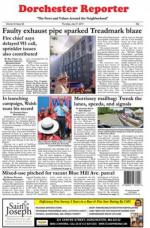December 8, 2016
It was breezy on the morning of Dec. 3 as a crowd led by city officials brandishing megaphones set off on an excursion eastward down Columbia Road from Franklin Park to Moakley Park in South Boston.
The tour’s aim was to envision what the neighborhood along the thoroughfare might one day look like as a result of the city’s urban planning initiative, Imagine Boston 2030. Hopefully, walkers said, a cleaner and greener path was ahead.
“Our goal is to visualize the plan, participate, and engage with city leaders,” said Natalia Urtubey, the director of engagement for Boston 2030.
Among the walkers were representatives from Boston Parks, the Boston Transportation Department, the Boston Planning and Development Agency, and the Office of Economic Development.
It was off to a paradoxical start: Most in the group had driven to Franklin Park to discuss environmentally-friendly enhancements to the community, instead of biking, walking, or taking the MBTA.
Discussion along this leg of Imagine Boston 2030 Week’s events took up the possibility of extending Frederick Law Olmsted’s Emerald Necklace into parts of Dorchester. The seven-mile chain of nine parks now links parkways and waterways from the Boston Common and Public Garden along the Muddy River and Leverett, Willow, Ward’s and Jamaica ponds through the Arnold Arboretum to Franklin Park at Dorchester’s northwest border.
Officials stressed that the purpose of the walking tour was to enhance the flow of ideas that might bring increased opportunity to Dorchester with sustainable solutions. As the walk progressed, the conversation quickly expanded beyond greenways to cover education, housing, and unemployment as key elements to any overall neighborhood improvement.
Over 12,000 voices have shaped the first draft of a plan for Imagine Boston 2030 in workshops, surveys and forums that targeted inequality, affordability, climate change, technology, the growing population and the economy.
“Although physically situated at the juncture of some of the city’s largest and most celebrated open space assets, some of Boston’s historically underserved neighborhoods, including Dorchester and Mattapan, are disconnected from nearby green space and the city’s broader parks network,” the draft report reads.
“Investments in local assets, such as Franklin Park, can provide an anchor destination for local communities and residents from across the city. Completing the Emerald Necklace through Dorchester can provide a multimodal connection between historically underserved areas, the waterfront, and other open spaces across the city.”
Nidhi Gulati, the Emerald Network Program Manager, said that she hopes to see 70 new miles of greenway over the next 15 years, noting that building such a system offers flexibility, with a number of ways to connect them. “What we can do is build safe connections so that you can hop from green to green,” she said.
Those leading the walk encouraged the re-imagining of the landscape, and as they passed the bike lanes along Columbia Road, there was agreement that more could be done to make the route aesthetically pleasing.
The plans for Franklin Park in the ‘80s and ‘90s, were “bold, ambitious, and totally destructive at the time,” said Christopher Cook, the commissioner of the Boston Parks Department. Now, he said, there is an opportunity to reinvent the space.
At Uphams Corner, the conversation turned to the economy. Construction opportunities were seen as a way to create jobs, but the threat of housing displacement loomed darkly over the discussion. Still, residents and city officials made it clear that the one thing they don’t want to alter is the vibrant identity of Dorchester. In that context, talk of the continuing municipal commitment to the Strand Theatre was met with cheers and applause.
Education was another issue the group addressed as they walked through the neighborhood, at one point passing the Jeremiah E. Burke High School. Rahn Dorsey, the city’s education chief, called the Burke one of the “movers and shakers in our Boston public school system.” By encouraging social-emotional learning among its goals, Dorsey said, the school became a model for the future of Dorchester.
“We have to think about how the city becomes a classroom for our students,” he said, “but it’s dependent on economic inclusion. If we don’t take care of poverty, the schools can only go so far.”
Access to green space and healthy transit options are intertwined with good education and bolstering local economies, walkers said. As organizers discussed extending the Emerald Necklace through foundations, public funds, or government assistance, residents asked that they bear in mind the potentially beneficial ripple effects across underserved communities.



